Bunyoro-Kitara Kingdom 1400
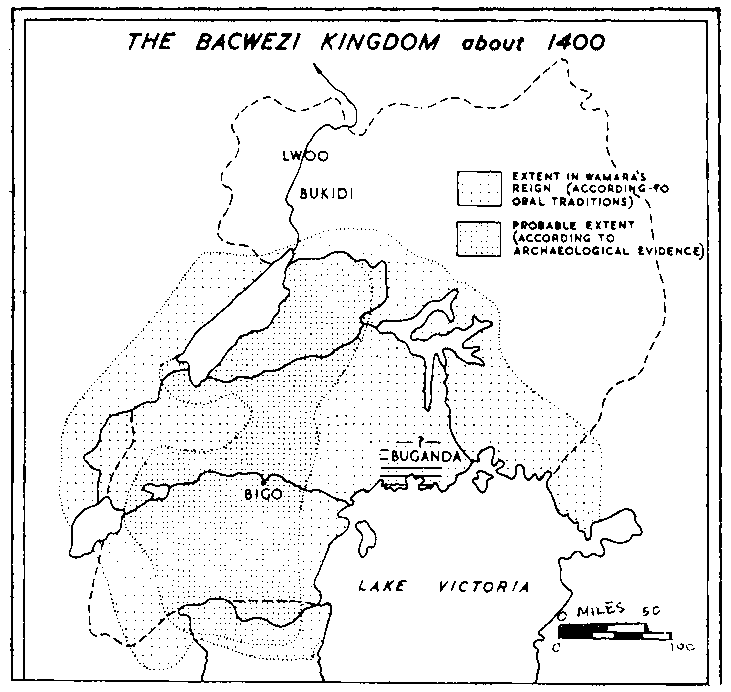
Bunyoro-Kitara Kingdom 1700
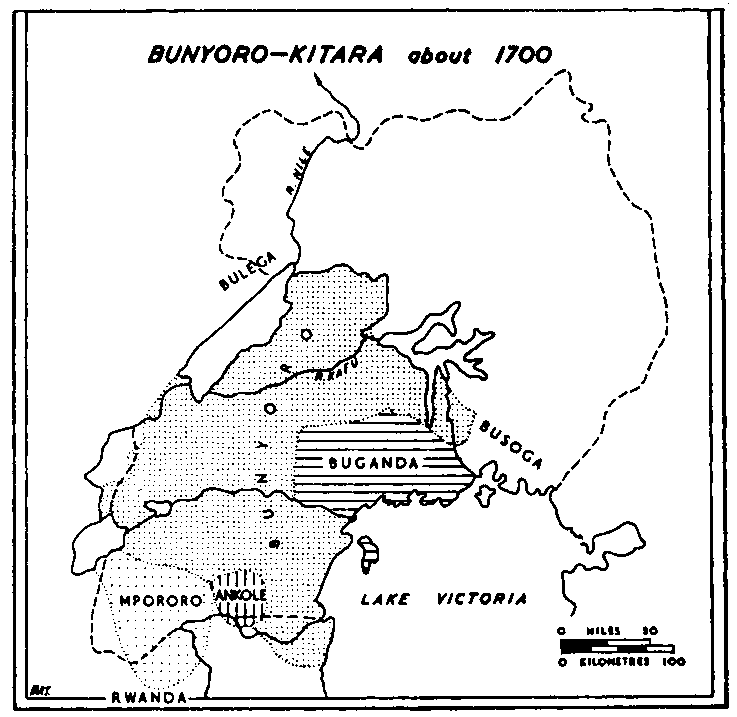
Bunyoro-Kitara Kingdom 1820
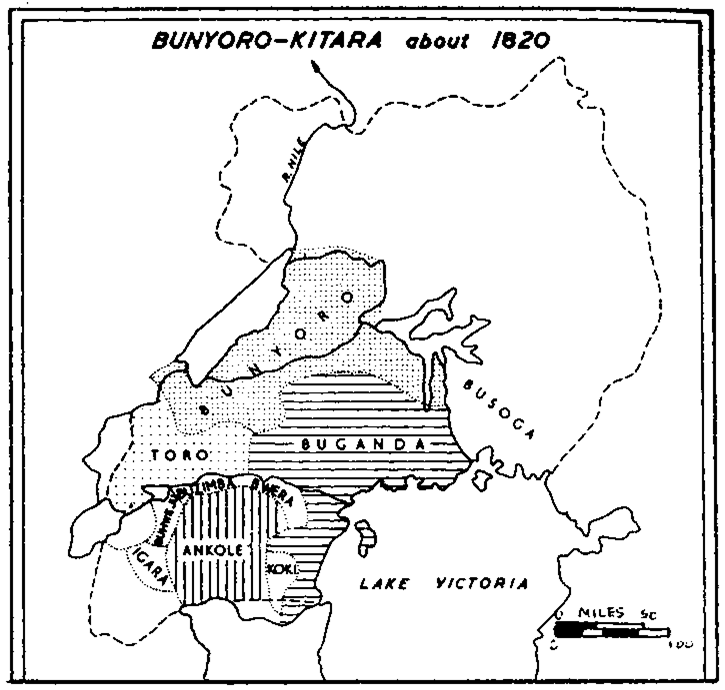
Bunyoro-Kitara Kingdom 1962
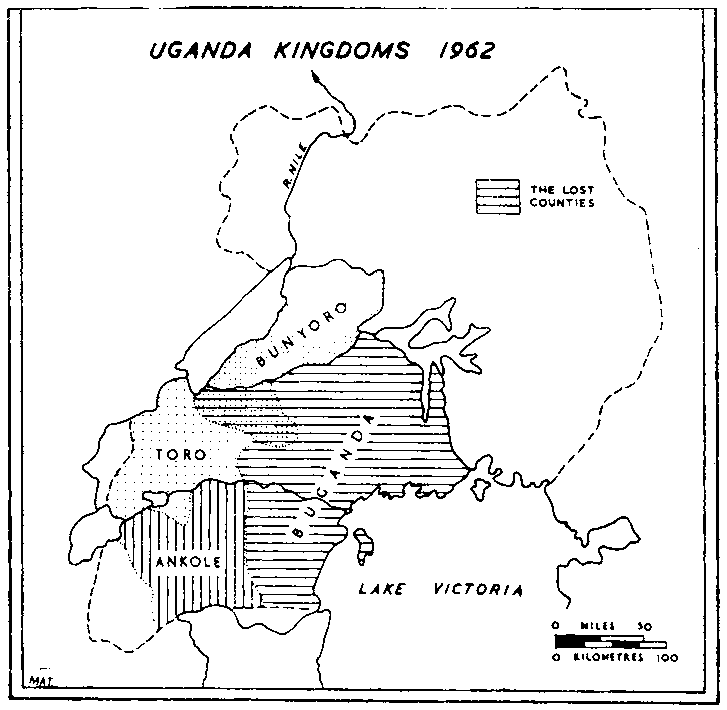
Bounday given by Lugard 1891
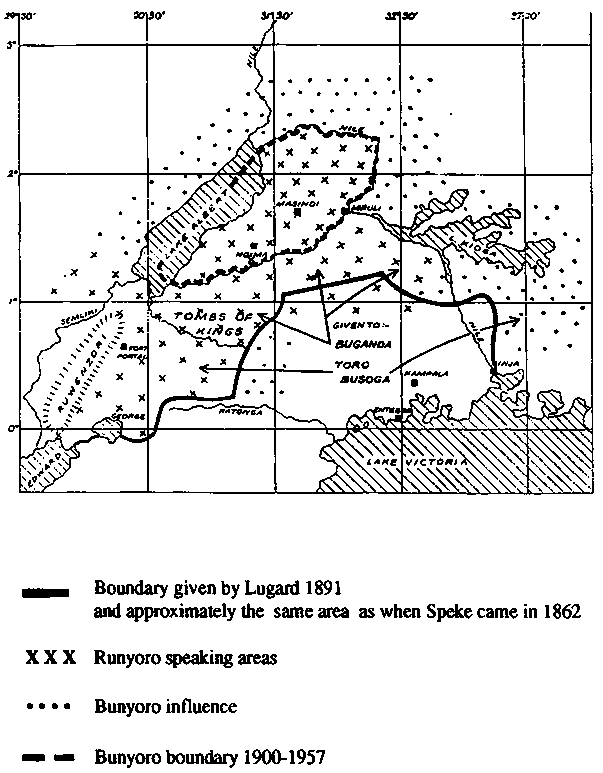
Land Transfered to Buganda by the British Government in 1893
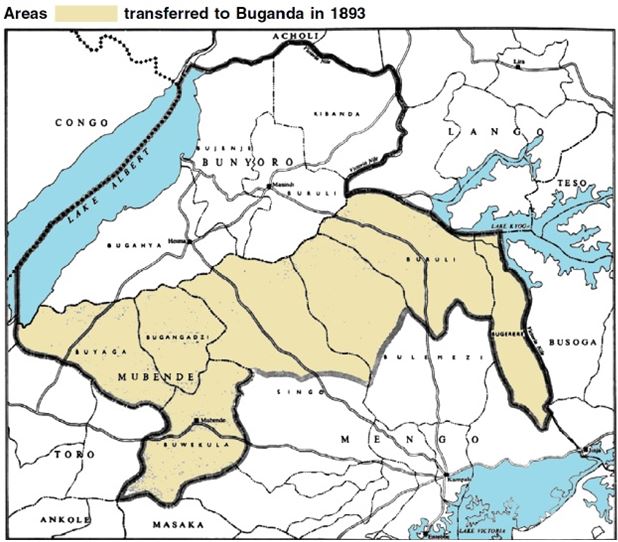
ORIGINS OF BUNYORO-KITARA THE OMUKAMA’S (KINGS)
The Struggle to Regain the Lost Bunyoro Territories
- ● Buyaga
- ● Bugangaizi
- ● Buhekura
- ● Buruuli
- ● Bugerere (Bunyara)
- ● Bulemezi and
- ● Rugonjo (Kiboga and Kyenkwanzi)
Uganda @50 Daily Monitor Articles
Ugandan king battles Oxford museum over lost throne
https://www.theguardian.com/world/2014/jun/14/uganda-king-oxford-pitt-rivers
Britain to return Bunyoro’s artifacts
https://www.monitor.co.ug/News/National/688334-3428258-op205i/index.html
British university holds onto Bunyoro cultural artifacts
Life and times of Omukama Kabaleega
Kabalega to Colville: Over my dead body
http://www.monitor.co.ug/SpecialReports/ugandaat50/1370466-1374480-14dcf9d/index.html
Having ‘eaten’ Buganda, British turn to Bunyoro
http://www.monitor.co.ug/SpecialReports/ugandaat50/1370466-1373546-14dbqma/index.html
Banyoro, Muslims unite to kick Buganda in the groin
http://www.monitor.co.ug/SpecialReports/ugandaat50/1370466-1367480-14crybk/index.html
BUNYORO-KITARA ILLEGALLY GIVEN TO BUGANDA
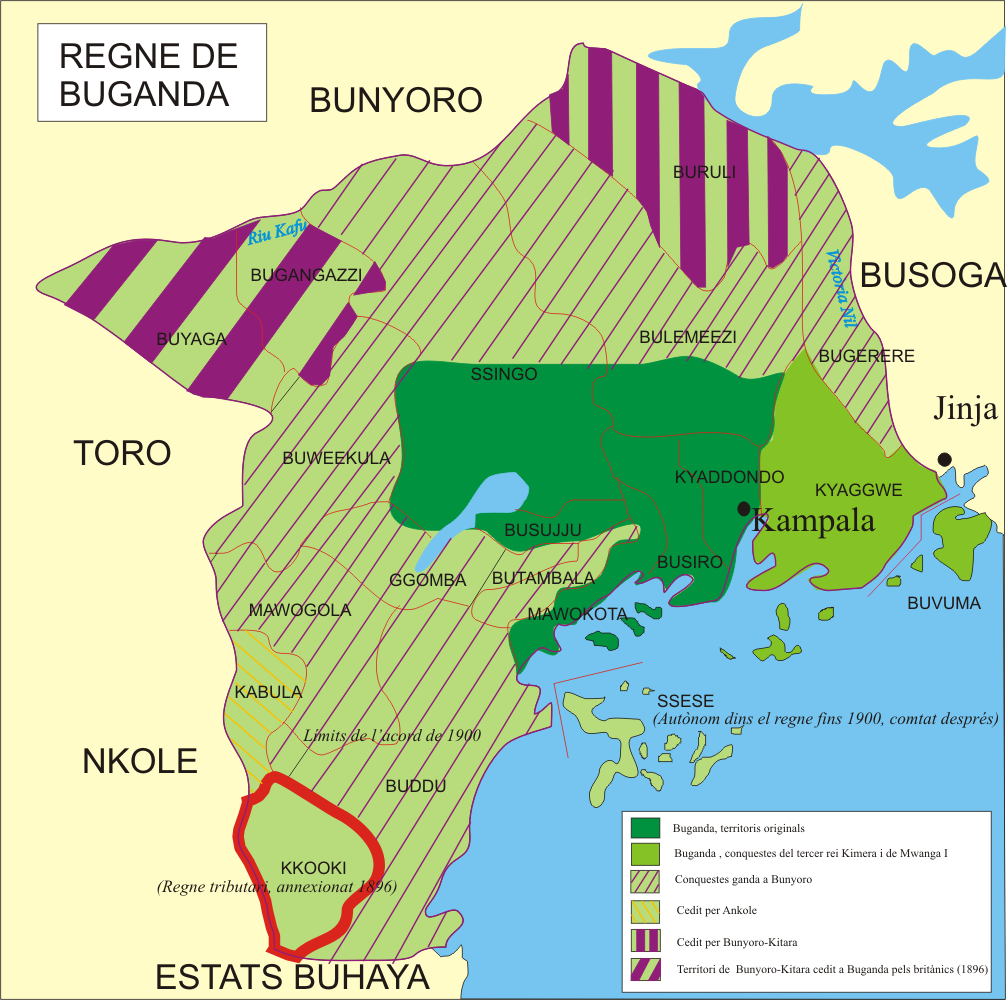
End of an era as Kabalega, Mwanga are sent into exile
http://www.monitor.co.ug/SpecialReports/ugandaat50/1370466-1380932-14dvanw/index.html
The betrayal and capture of Mwanga and Kabalega
http://www.monitor.co.ug/SpecialReports/ugandaat50/1370466-1379638-14dfxax/index.html
Bunyoro revolts against Buganda sub-imperialism
http://www.monitor.co.ug/SpecialReports/ugandaat50/1370466-1387154-14e0yoa/index.html
The rise of sub-imperialism and its rejection in Bunyoro
http://www.monitor.co.ug/SpecialReports/ugandaat50/1370466-1385646-14dyoxe/index.html
Inside the devastation of Bunyoro
http://www.monitor.co.ug/SpecialReports/ugandaat50/-/1370466/1375826/-/ujk9usz/-/index.html
The great Buganda land grab of 1900
http://www.monitor.co.ug/SpecialReports/ugandaat50/1370466-1387958-14e15y2/index.html
Kabalega: The king history tried to forget – and failed
http://www.monitor.co.ug/SpecialReports/ugandaat50/1370466-1383478-14dx9su/index.html
Kabalega refines his art of war as British hunt blacks
http://www.monitor.co.ug/SpecialReports/ugandaat50/1370466-1375172-14dd27c/index.html
Original Bunyoro-Kitara Territory
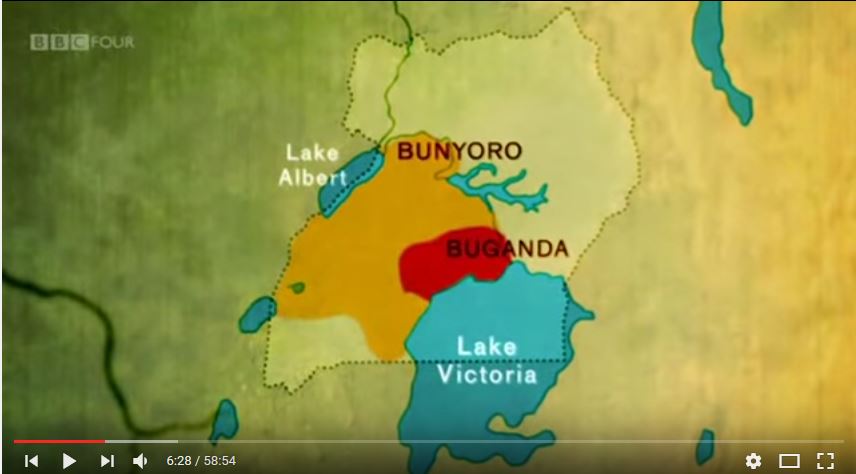
Current Bunyoro-Kitara Territory
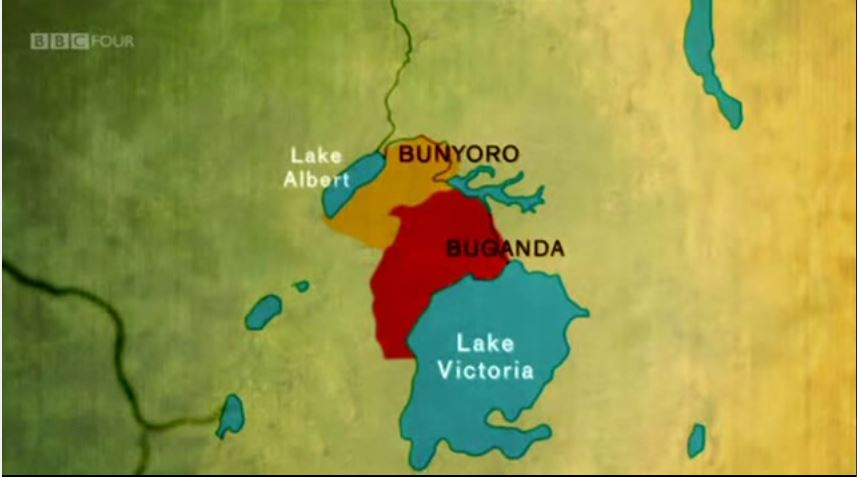
Isaza is remembered to have been the first king to divide Bunyoro into Sazas. Some accounts reveal that the word Amasaza counties was coined from the name Isaza, ruler of the time. He appointed chiefs, whose names appear in the surviving accounts.
In his appointment, he showed gratitude and respect to the old men whom he gave many counties (saza’s) to rule. For he remained their overhead and unifier who could command and summon them at any time. He assumed the name of Nyakikooto – meaning the greatest of all saza chiefs and the lord of all.
The first Saza Chiefs whom he appointed (the old men) were given Saza’s as follows:
|
Nyamenge |
was given |
Kitara (Kyaka Saza) |
|
Ntege ya Koya |
was given |
Muhwahwa (Buganda) |
|
Machumulinda |
was given |
Nkore (District) |
|
Ntembe |
was given |
Busoga (District) |
|
Kabara |
was given |
Bugangaizi (Saza) |
|
Nyakirembeka |
was given |
Mwenge (Saza) |
|
Kogere (his aunt) |
was given |
Busongora |
|
Nyangoma (his sister) |
was given |
Buruli (Saza) |
|
Nyamurwana |
was given |
Bugahya (Saza) |
|
Nsinga |
was given |
Bugoma (Southern Bugahya Saza) |
|
Ichwamango |
was given |
Bungungu (Northern Bujenje Saza) |
|
Kaparo |
was given |
Chope (Kibanda Saza) |
|
Kalega |
was given |
Bulega (The West Bank of L. Albert) |
|
Mukwiri |
was given |
Bwera (Buddu) |
|
Nyakadogi |
was given |
Busindi (Buruli Saza) |
|
Nyakaranda |
was given |
Bunyara |
While these names continued to appear in the surviving account,
LIST OF CLANS OF BUNYORO-KITARA AND THEIR TOTEMS
The following clans have the bush-buck (Ngabi) as their totem
|
1. Babiito (Royal Clan) |
12. Abahemba |
|
2. Bachaki |
13. Abaziraija |
|
3. Abahyakwa |
14. Abagorongwa |
|
4. Abalyebeki |
15. Abapasisa |
|
5. Abanywagi |
16. Abagaya |
|
6. Ababworo |
17. Abatabi |
|
7. Abakwonga |
18. Abahemba |
|
8. Abadwalo |
19. Abatwairwa |
|
9. Abajagara |
20. Abapina |
|
10. Abagomba |
21. Abasengya |
|
11. Abamwolo |
22. Abatembe |
The following clans have two totems. In addition to avoiding the bush buck totem, they also avoid Malegyo (rain water from the roof of a house).
|
Bachaki |
|
|
Abangamwoyo |
Abacwera |
|
Abacwa |
Abasiita |
|
Abagweri |
Abasengya |
|
Abagumba |
Abalisa |
|
Ababombora |
Abagimu |
|
Abandikasa |
Abalega |
|
Abahangwe |
Abaligira |
|
Abategwa |
Ababworo |
The following clans have their totems (Omuziro) dealing or related to the Cow.
|
Clan |
Totem |
|
Abanyakwa |
Ngobe, cow with short straight horns. |
|
Abasita |
Busito, pregnant cow |
|
Ente Emira, cow which has drunk salt water. |
|
|
Ababyasi |
Busito, pregnant cow |
|
Abacwezi |
Busito, pregnant cow |
|
Ente Emira, cow which has drunk salt water. |
|
|
Ababemba |
Busito, pregnant cow |
|
Abasaigi |
Nkira, tail-less cow. |
|
Abasingo |
Mulara, black cow with white strips down face and back. |
|
Abasingo |
Ntimba, brown and black cow. |
|
Abangoro |
Mulara, (they split from Abasingo because their companion had killed a man and they feared the consequences). |
|
Abami |
Mpuga, spotted cow. |
|
Abagimu |
Mpuga, spotted cow. |
|
Abayanja |
Kitale, white cow. |
|
Abakwakwa |
Ngobe, cow with short straight horns. |
|
Abatwa |
Milch cow. |
|
Abanyonza |
Ntimba, brown and black cow. |
|
Abaranzi |
Ntimba, brown and black cow. |
|
Abalisa |
Ntimba, brown and black cow. |
|
Abagahe |
Ntimba, brown and black cow. |
|
Abafunjo |
Ngobe, cow with short straight horns. |
|
Abalebeki |
Ngobe, red and white cow. |
|
Abagimu |
Ngobe, red and white cow. |
|
Abaligira |
Ntimba, brown and black cow. |
|
Ababworo |
Ngobe, brown and white cow. |
The following is a list of various clans and their avoidance objects (Omuziro).
|
Clan |
Totem |
|
Ababworo |
Omutima, heart of animal |
|
Abanyama |
Omutima, heart of animal |
|
Abasita |
Muka, dew on grass. |
|
Abaosara |
Butweke, woman who enters a kraal, solicits the owner’s son and bears a child to him. |
|
She must never enter the kraal of the clan again and have any member converse with her. |
|
|
Butweke also means a girl who is pregnant. |
|
|
Abagabu |
Ntuha, Crested Crane. |
|
Abagabu |
Kawaisomba, geret cat. |
|
Abasaigi |
Njobe, a certain animal. |
|
Abasengya |
Orulimi, tongue of animals. |
|
Abaregeya |
Nkobe, monkey. |
|
Abaregeya |
Musokiso, bird – these separated from the Abasengya. |
|
Abakaikya |
Kagoma, the large eagle – bird that carries away small goals and like animals, and birds. |
|
Abasonde |
Rubeibere, Cock. |
|
Abanyonza |
Nyonza, bird. |
|
Abaraha |
Akanyamasole, wagtail. |
|
Abaraha |
Akatenge – tedge. |
|
Abayaga |
Kanyamunkonge, bird. |
|
Ababiiro |
Ndahi, guinea -fowl. |
|
Abanana |
Ndahi, guinea -fowl. |
|
Abahenga |
Kagondo, small black water bird. |
|
Abanyampaka |
Kagondo, small black water bird. |
|
Abaiegeya |
Ndegeya, bird. |
|
Ahengo |
Leopard skin, these separated from Abasingo due to a quarrel over a skin. The skin which caused the havoc became their new totem. |
|
Abasaizina |
Mhogo, buffalo. |
|
Abafumambogo |
Mbogo, buffalo. |
|
Abafunjo |
Munyerere. |
|
Abairuntu |
Njojo, elephant |
|
Abanyama |
Isereke, woman who is a stranger and is nursing a female child. |
|
Abakimbi |
Isereke. |
|
Abayangwe |
Nkende, grey monkey. |
|
Abayangwe |
Nkobe, large monkey. |
|
Abahinda |
Nkende. |
|
Abagweju |
A house burned down. |
|
The place is avoided and no vessels from such a house should be used by the member of the clan. |
|
|
Abatongo |
Amara, the stomach of animals. |
|
Abafumambogo |
Nsenene, grasshopper. |
|
Abasonga |
Nsenene, grasshopper. |
|
Abahango |
Nsenene, grasshopper. |
|
Abayaga |
Nsenene, grasshopper. |
|
Abayaga |
Oburo, millet |
|
Abayaga |
Guswera, a fly. |
|
Abasambo |
Obutweke, pregnant girl. |
|
Abasambo |
Nkuuku, kind of peas. |
|
Abasuli |
Mbuzi, goat. |
|
Abakame(i) |
Aki wakame, Hare. |
|
Abasogo |
Akaibo Kateirwe ha mutwe(basket put on the head). |
|
Abagombi |
Akaibo Kateirwe ha mutwe(basket put on the head). |
|
Abagombi |
Biwetu, sugar cane. |
|
Abachubo |
Guchu. kind of fish. |
|
Abagere |
Njoza, an antelope. |
|
Ababopi |
Ekigongoro, centipede. |
|
Abazazi |
Guchu, kind of fish. |
|
Abaisanja |
Epo, kind of Antelope. |
|
Abaduka |
The old skin of a drum |
|
Abaho |
Kalogi, fungus growing on trees. |
|
Abasihiri |
Ebihunna-Mayuni, Yams. |
|
Abahembo |
Kaibo Masa, empty basket. |
|
Abahamba |
Ensonga, a certain plant. |
|
Abakorwa |
totem not known. |
|
Abaseke |
totem not known. |
|
Abagonza |
totem not known. |
|
Ababaki |
totem not known. |
|
Abasindika |
totem not known. |
|
Abaginga |
totem not known. |
EMPAAKO BUNYORO-TOORO
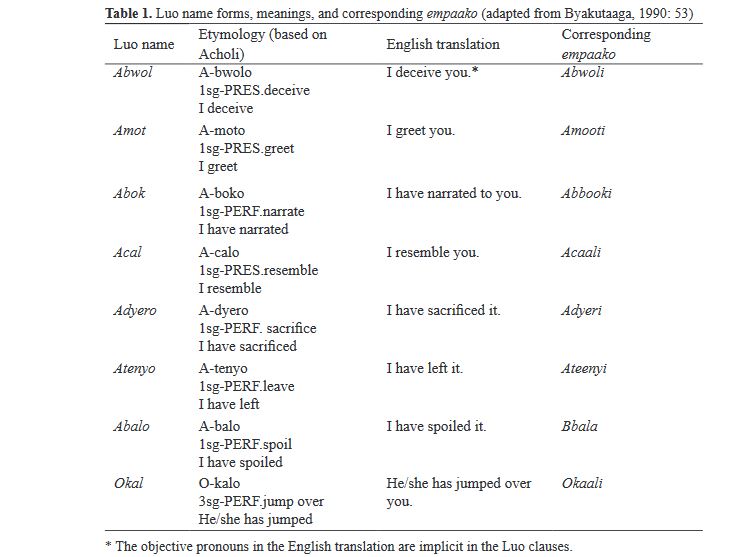
Empaako belong to a special category of personal name used primarily in the Runyoro and Rutooro speech communities.(1) They were introduced in the early modern period, around the 14th century (Bunyoro-Kitara Kingdom). No proper equivalent of empaako exists in English. The British hastily equated them to “petnames,” but this term is clearly a misnomer based on the functions of empaako, one of which is to show respect, as pet names are associated only with intimacy, endearment, and familiarity (Byakutaaga, 1990). Kihumuro (1994: 30) argued that the term empaako should instead be rendered as “praise names.” The use of empaako is the most idiosyncratic linguistic feature distinguishing Runyoro and Rutooro speech communities from speakers of other Bantu languages (Byakutaaga, 2010). Although empaako pervade everyday discourse among Runyoro and Rutooro speakers, only 12 names are used: Abbooki, Abwoli, Acaali, Adyeri, Akiiki, Amooti, Apuuli, Araali, Ateenyi, Atwoki, Bbala, and Okaali. Okaali is reserved exclusively for the king, leaving 11 empaako to be shared among almost 2,000,000 people, as every person in the two speech communities ideally has such a name (Byakutaaga,
2010).(2) This intensive use of a small set of names raises the question of whether empaako are referentially optimal name expressions. These terms are not typical Runyoro or Rutooro names; they were borrowed from Luo (a Nilotic language) following the Biito (an aristocratic Luo clan) conquest of the Bunyoro
Usually, Luo personal names beginning with a are female names, and those beginning with o are male names. However, some male Luo names begin with a (e.g., Akena, Amone, Abok, Acire,
Ayella, Acika and Acaye) (cf. Odonga, 2012) and, less commonly, some female names begin with o (e.g., Oyella). Although the predominant use in Luo of the first person singular (i.e., beginning with a) for female names and the third person singular (i.e., beginning with o) for male names is interesting, a complete examination of this pattern is beyond the scope of this study. Most names in Table 1 begin with <a> and thus are predominantly female, with the exception of the male name Abok (similar to, e.g., Acaye, Amone and Akena). According to my Acholi-speaking (a Luo dialect) informants, all the female names in Table 1 have corresponding male names (e.g., Obwolo (see also Odonga, 2012: 372) for Abwol, Obala (see also Odonga, 2012: 368) for Abalo, Omot for Amot, Ocal for Acal, and Otenya for Atenyo). The differences in the endings of the names (e.g., Atenyo vs. Otenya) are orthogonal for the current purpose.
[info_box title=”More About Empaako/Praise Names”]Follow this Link Below to Read More About Empaako
Empaako History[/info_box]
[info_box title=”The Historical relationships between Banyoro and Baganda”]The Historical relationships between Banyoro and Baganda
Banyoro and Baganda History[/info_box]
MONTHS OF A YEAR IN BUNYORO AND THEIR MEANING
1(JAN).BUSWAGU;
2(FEB).KAYAGA;
3(MARCH)BWANSWA;
4(APRIL).ITOIGO;
5(MAY).NYAMUJUNA;
6(JUNE)KASAMBURA;
MONTHS OF A YEAR IN BUNYORO AND THEIR MEANING
7(JULY).ISENYA;
8(AUGUST)MUKONANTAIKE
9(SEP).IRUMBI/ITUMBA;
10(OCT). KACUNGIRAMWERU;
11(NOV).MUSENENE;
12(DEC).KYANDA.
ENFUMO BUNYORO-KITARA KINGDOM
1. Ababiri bamira ebigambo, abasatu babisaturura
2. Abagenda babiri baijukyangana
3.Abaingi banobwa atubire
4.Abakama nsozi, zihikaana ekiro
5.Abanyineka batongana bairaba
6.Abaragaine tibetana
7.Abasaija mahungu bagwa nibaimuka
8.Abataahi bisagazi, biikara nibyomba
9.Abataahi bisagazi baikara nibakungana
10.Aboruganda bita tibyatangana
11. Aburwa eky’aragamba, ngu so obw’alifa oyombekere nyoko
12. Ag’okufa gameda, ag’okwihuka gatengeeta
13.Agabagaya nugo gabutosa
14.Agabira abarongo abainganainganiza
15. Agafundukire gatambwa oturo
16. Agamba eky’amalya abiri, ngu yalenga
17. Aganjaine akira atemere
18. Agarukamu ebigambo, ateeza muka iba
19.Agateraine nigo gata eigufa 20.Agenda naacura tabitunga
21. Agira itima ali muto, obwakura aroga
22. Agonza akasera akarungi akegoyera
23.Agonza nyakabu tagabuka nawe
24.Ahanbya ibiri zimuleka
25.Aharana abe agaigahaza abafumu
26.Ahereera ekiswa atukura
27.Ahereka ataswire, bamwetera miguta
28.Aigusa ensaho emuniga
29. Akaana akatabunga, ngu mau acumba obunura
30. Akaana akateema kalya ebi katamanyire
ENFUMO BUNYORO-KITARA KINGDOM
31. Akaana ka hara, kalima ob’owabu bahoire
32. Akaana katali kaawe, akati ocwa hara
33. Akaana nibakaima oburo bw’orufu, ngu abarwaire n’owaitu baliyo balifa ndirya
34. Akabenga ak’otabohere kaisa ekihika
35.Akabwa akadoma kaboigolera enjojo
36.Akabwa akaigusire okarora ha midaliro yako
37.Akabwa akasuma kaholerwa omugongo gwako
38. Akagambo ko mukuru mukaro oijugaho no gayaho
39. Akahururwa akaracwa omuhoro kagwezingirra
40.Akaigo akateire mukabaro okanaga haraira
41.Akaigo akatire muka baro, obw’okagwaho okanaga hara
42.Akaikalirize kendesa muko mutahi
43.Akakira kembuzi keyera ebyamire
44. Akaana akatabunga kaikaliza nyina wako niwe acumba obunura
45. Akanaga akacumbire encu tikahwa inunka
46. Akanaga akacumbire encu tikahwa inunko
47.Akanyonyi kahara kasoma nikarora ha bwire
48.Akara akahoire omunio kaihayo amazi
49.Akaraba katahyo okaroora ha mukonda gwako
50.Akasoro akabunga muno kagaruka n’ekicweka ky’omuguha
51.Akati bakagema mamera/nikakyalikato obukakura kahendeka
52.Akesamiriire kaingi kakabuza oruhazi orukanakana
53.Akucumbira eyo mutwe omucumbira eyebigere
54.Akuha n’omuha nizo engonzi itafa
55.Akuhana kulima, obw’oyeza tomuha
56.Akuheera enda oburwa engozi y’okumuheeka
57.Akukira oyemeriire n’obw’oikarra akukira
58. Akunobere akweta n’olya
59. Akuteera orubaale, tarukumwereera
60. Akutwara ekiro omusiima bukiire
ENFUMO BUNYORO-KITARA KINGDOM
61.Akwata mpora omukama amuhika, omuniongorro gukahika ha iziba
62.Akweteireho niwe obawe
63.Akwirukya niwe akwolekya omuhanda
64.Akwohya akuseka
65. Akyenda akibona omugara na zara omuli
66. Alima atoosere, tabura rubimbi
67. Alima na iba taba mugara
68. Alinda kihweyo acumita omukira
69.Amagezi muro bagaihanganaho
70.Amagezi murro, bagwihanganaho
71. Amahano bagakaguza rwagabwoine
72. Amahiga gahigikururwa rwagahigikire
73. Amaizi gatanga embwa, ngu nyamburra entaama yange?
74. Amaizi obugagira ngu otannywa, naiwe ogira ngu tinyina iroho
75. Amaizi tigebwa mwabugo mbeho
76.Amaizi tigeebwa owabu mbeho
77.Amajahya ga nyamunkanga, aita enswa ayanika ebyoya
78. Amara kulya ngu owaitu bakunyeta
79. Amara kulya ngu owaitu banyeta
80. Amara kutunga ayeta owabu mwinazi
81. Araakubalisa ebisuba, ngu eky’ogambiire nyowe okiziikire
82. Araiguta bamugabira naarazira
83.Araire kubi bamurora ha mazinduka
84.Arakubinga ha njubo akutera oburogo
85.Arakuha emyongo akubandiza ha bisunsa
86. Arakuha enkole akubandiza ha mugobe
87. Arakuteera obwekuniki akuramukya n’onywa amaizi
88. Arakuteera takubaliira bwanuki
89.Arakutera ebisuba, ageya nyoko oroho
90.Arakutera obuli akuleka n’olya
ENFUMO BUNYORO-KITARA KINGDOM
91.Arakwiha emize akuramukya nolya
92.Arakwiha omuze akumulika obyamire
93.Arakwima akugamba weyolereho
94. Arakwohya ngu giite eragoba
95. Aralya akomukuru amuberebenja
96.Aramura abatamizi aseera mbale
97.Aranga engoma niwe agyetwika
98.Arungira enobi (ekisura rundi omunyo) asaaliza
99.Arwehaire asendekereza abatamizi
100.Asaaswa nuwe ayara
101. Asendekerezebwa munywani we akarora enyuma, obutiini alifa nabwo
102. Asera obuhuta anywegera oruhazi
103. Asweka ibiri taboija
104.Ata oburungi omu nkiro abusangayo
105. Ataafe aitirana omukunzi wa nyina
106. Atafune asubura amahuli nensoha
107.Ataha ekibira tatiina bikukonoga
108.Atakuboine omunyeto akwegayira
109.Atakwatulire tolimanya kimuruma
110.Atali nyoko, akuha embibo isiga lihoire
111.Atamuzaire niwe agimulenga
112.Ataroho nuwe aita engo
113.Ataroho taterwa muti
114.Atega gumu anyaata
115. Atungire ayomba, omuzaire ayegadika
116. Ayanga kugwa bamuniga bwemi
117. Ayanga kugwa, anigwa bwemi
118.Baanobere bagyeha
119.Babuserurra omu kiswa kunu buli omu mpike
120.Bacwezi njuna nagawe oteireho
ENFUMO BUNYORO-KITARA KINGDOM
121.Bafa babireka nuwe alya
122.Bagamba kondi akabu babyamiire
123.Bagaya akatojo, nikabacumbagiza
124.Bagonza enku banoba omuseenyi wazo
125.Bainganaingana bituuro
126.Baita omusuma omuleegi n’ahyata
127.Bakincwire oba okinagireho
128.Bakintemere buli akinagireho
129. Bakubinga omukisiika ngu nyowe n’omwidiiro ndabyama?
130. Bakweta kulya ngu balikanyihaho
131. Bakwima oroho ngu obundarugaho baranyahurra
132. Bakwimire oroho nti barakwahuura
133.Bakwoleka okwezi ohambwa n’enyunyuzi
134.Baleka niruleeta, tibaleka orufiire enda (oruseke)
135.Balimpolera obwo ofwire
136. Bamarumi bangonza azaarwa na nyoko aroho
137. Banobere nyoko ngu iwe omwana ijaga nolya
138. Bansweke ntagate buli akabyeguura
139.Barucwera igete rwita aguruka
140.Barwenda akatahya empisi obugenyi
141. Barwongorereize..omusezi atembere esukuta
142. Basaija mahungu bagwa nibaimuka
143.Biri omwo, ekyamya omunwa
144.Biriija ndigura akajwara nanyina enkanda
145. Birija ndigura akajwara na nyina ebitengo
146. Bugu bugu tiguba muliro
147. Bunanka tindigyayo, ekirikutwarayo tokimanya
148.Butota bateiremu omwiko
149.Byerera abataina maino
150.Ebibalima baina enda nibyo balya bazaire
ENFUMO BUNYORO-KITARA KINGDOM
151.Ebibanagaija babijuka enjara egwire
152.Ebibarora tinibyo bagamba
153.Ebifeera munda bisemeza amalembo
154.Ebiffera munda nibyo bisemesa amalembo
155.Ebigere bikera omutima haguraire
156.Ebihiire tibabyahurra abagwijagiire
157. Ebike biriibwa bake, omukazi tabegera iba obusera
158. Ebirungi babireka nibinura, embwa akaleka enseko
159. Ebirungi biba hara, irebe mu nyanja
160. Ebyangire eka omuleju gukamera ha kidokoli
161. Ekibi tikiburwa muleesi
162. Ekigambo kirungi kikaraaza empisi ha rugo
163.Ekigwo ekirakwima enseko kigwibwa nyokozara
164.Ekija omanyire kitwara bike
165.Ekikere tikirimanya omugaso gwa amaizi kuhikya bugoma/gamazire kwoma
166.Ekimi eky’okwasire kikira amagana agali aheeru
167.Ekiraita nyakabwa kigigara enyingo
168.Ekirakuhemura okijwalirana
169.Ekirakulya kija norora
170.Ekirakulya obinga nikiija
171.Ekisemerra omutwazi, buli n’omutwalirwa
172.Ekiso kyembuzi kireka omwisi kitunulira omubagi
173. Ekitaroho tikiriza mwana
174. Ekito kito ekikuru kikuru, enkoko esoma eky’eramira
175. Ekitonge kikoto kimara enjara baitu kireka ekihemu
176.Eky’otakaliire tozina gudiikiire rundi tosangwa wayesama
177.Eky’ozaire tonaga, ekyoma tokijarabanga
178. Ekyana kyempunu okiroora ha munwa gwakyo(ebunyindo byakyo)
179. Ekyanga kwoma baanura, embwa n’etalika enyindo zaayo
180.Ekyanika nsimbi kizara mporaho
ENFUMO BUNYORO-KITARA KINGDOM
181.Ekyotakaliire nozina kudiikire
182.Ekyoyenda kikuseeza
183.Ekyozaire tonaga
184.Emanzi eteera n’enagirra ogonza ebe y’owanyu
185. Embandwa y’omunaku teragura, obwegamba kuragura ngu mukama wayo
186. Embwa eyotoroire togikwata mukanwa
187. Eminwa ogitwara namberi baraginywegera
188. Empisi n’enagwa orucwamba, ngu n’obulya aheru bwanyita
189. Enaku musana tigwokya omu
190.Enduuru yokulya batera ntaito/nke
191.Enfuka obw’ecweka ehirra omugara
192.Engabi eyerinda, efa garamaire
193.Engaya bakama tegaya omu
194.Engobya n’engobya ikombeka ha mugongo gumu
195.Enjara ekwiha omwa nyokozaara, buli ekwebarra kukwita
196.Enjojo teremwa masanga gaayo
197.Enjura egwa kyamutwara, obuterezi bunaga ente karagwe
198.Enkoko bagijunira nekyapapara 199.Enkoko ehaba omulyango efa
200. Enkoko nenaga ihuli omu zigati, ngu arakasaaswa akome
201. Ensorosozi etaakule emera ebyoya
202. Enswaswa eteeyanwire ereega engalabi
203. Entasiima eburwa agiha
204. Enyana eyeteega, omwiguto guruga omw’ibeere lya nyinayo
205.Erabura ezara abaisiki
206.Erafa tehuura ngwaara
207.Eranena teboikora
208.Erateera tejunjura
209.Esojo ecumita nekyalinto bwekura esakara enju
210.Gabiraga zoona, tomanya ey’olitaahya
ENFUMO BUNYORO-KITARA KINGDOM
211.Hahumura amaguru, akalimi tikahumura
212.Hakyoto kyabakuru bwotaihaho emigisa oihaho emikyeno
213.Hali nyineka atali ebikere bitemba enju
214.Hali oitiire tobaagiraho
215.Ihali lingi, lihemesa ekituuro
216. Ihe tirikaijwire, ngu baihemu abagurusi kaatatungire
217. Ikara aho ekuhebwa nyineka
218. Kabinegene buli bina kisagurwa
219. Kakije ndole okihuliira mu mbanda
220.Kamu kamu nugwo muganda, omuntu kumwesiga mu biingi babanza kumurorra
221. Karabateba: omukazi akuha amaizi akulekera oruyugi
222. Kasenyanku kagenda nebyako
223.Katali kale kagiza eisuma
224.Kawamalizamu nkogwekyanda
225.Kawe kawe okuguru kukutwike enku
226.Komba teingana tegura
227.Konodura nkomugara ayereze emyongo
228.Konokangaza nkentama ye kyara kimu
229.Konosalimba nkempunu neraba mu pamba
230. Konowehungulia nkomukazi womuleju
231. Kugabira akaana katali kaawe, ogabira nongo
232. Kumanyana nkumanya tibaswagirana
233.Kuramura abatamizi obaihamu entigiro
234.Kya hamugongo gunu, amara emigongo n’anaiga
235.Kyafuuka kabiri, akuliisa bibisi
236. Kyakwita muno ngu ayera amaino tanunka kanwa?
237. Kyozaire tonaga
238. Mboha nyenka amara ebigogo omu bitooke
239.Mboha nyenka ekamara ebigogo omubitoke
240.Mpankuhe nizo engonzi ezitafa
ENFUMO BUNYORO-KITARA KINGDOM
241.Mpora mpora ekahikya omuniongoro ha iziba
242.Muka baro ntembe, eky’akutembeka tokyejura
243.Muka nanka akaculeera buli aswirwe wenka
244.Naculeera acura nyina
245. Nali wawe akwita
246. Nalima harungi ainuka
247. Nambere bunurra ngu bacwereho embwa
248. Nanka tahuura okamulengahoira
249.Nazina kurungi aruga omwidiiro
250.Ndaijaga noija niryo eirembo eritafa
251. Ndakugambiraki?Aba akwimire orubazo
252. Ndekere musomeire, irembo aba aliisire
253.Ndihurra bakamucumbira omuki cooli
254.Ndiire ka maama nibwo obusuma
255.Ndimuka ekaikaliza nyineka omubisodo
256. Ngaro nsa zisemeza mukamabazo
257. Nkuroho anywana nambere wanywaine
258.Nkwikazire enaku nikwo mbyama
259. Nyakabwa tayebwa misitamiro ya nyina
260. Nyandima nke tahwa banseriire
261. Nyantagambirwa akanierwa omusorooro
262. Nyineka aitwa enjara, ngu bagoyere omugwetwa akasera
263. Oburwa ez’okugura omuhunda, ngu ndagirra ery’ekyanga
264. Obw’onoba kinyarwango, nziramire akazarwa n’oha
265.Obwesige bwingi bukabuza ekikere omukira
266.Obyamiire amatu nti enyindo zirahura
267.Ogumazire kurosa tigwita/ekimarara kuroosa tikiita/tikikyaita
268. Ohambiriza nk’omunaku, afa amaiso ngu ndaragura
269. Oku baramaga, tihali nikwo banyaga
270.Okuhabuza ekyanunka kandi munyanyoro asitamire
ENFUMO BUNYORO-KITARA KINGDOM
271.Okuhinguraniza mu kuserra itungo kukufeereza obundi eby’oinabbyo
272.Okwija obukuru haija enjaraomu bike
273.Oli kaburabuso komukazi ahoga nanyara
274. Oli kaburabuzo nkensambu ye bicoli
275. Oli kalemeso nkomwana aiba nyina
276. Omubazi gw’itungo tibasomaho, bakubisa bukubisa
277.Omubi, akurabya ha buko oyetwekere
278.Omugisa gwe ndahi tigurabya nkujumba murukaraiga
279.Omugobya tomutebeza ensita zaawe, alizekonyeza okukukora kubi
280.Omuk’omuhuuru tagira amatu
281.Omukaikuru bwabura nibwo empisi enia enzu
282.Omukubi oguralya akaro oguroraho
283.Omusu oguzaire tiguliibwa embwa
284.Omwa kiri butiini nibaseka, omwa kiri manzi nibacura
285.Omwana omwaka omuhyo, omuha akati
286.Omwigo gurwanirwa nkagutema hatali nkagukoma
287.Omwigo gwa hara tigukujuna njoka
288.Omwiguto guruga omu kwekomakoma
289. Omwongo tigukunamira nambere gwazairwe
290. Orugambo mpirima rusara embaju zombi
291. Oruseenene rwa ndakiboine, rwikara hamunwa gw’ensaho
292.Orusenene rwandakibwoine rwikara ha munwa gwe nsaho
293.Orutakule rumera ebipapa
294. Osanga akaana nikalya orukizi, ngu twekere taata enyama
295. Otagicumba otagyokya baitu nsange ehiire
296.Ow’omunwa arwanira ensonooki
297.Ow’otarukulema omukimbira omu mwirima
298.Owahaire ha siba enumi asangaho enyana
299. Owamaani make obulemu abutwara omubisagazi
300. Owamani make tagwa iraru
ENFUMO BUNYORO-KITARA KINGDOM
301. Owanyu mubi akubazaho kubi emyenda egomere
302.Owaruhanga ahaire nenumi ekamwa
303.Owebiniga aite ebye
304. Oweibango bwotamuhemukira towesweka
305. Owekisoro kitatwalire nyina aikaliza burakya turaseera
306. Owensoke ibiri takugambira ke okanuga
307.Owomuka tagwa nsimbu
308.Owomutwe mubi tahingurwa nkonyogo/ibaale
309. Ozaarwa wenka ngu omuhanda gusemerra babiri?
310. Ruswa parra!! ngu bunyata orame
311. Tibulikimasamasa ngu eba feeza
312. Tihaba mwika ahatali muro
313.Tindija taburwa ekimuleta
314.Tindya bamuroora hamubirigwe
315.Tingira andema aburwa obutaaho
316.Tingya habugenyi aba ataine kyokujwara
317.Tinkaroraga ensisa obukuru
318.Tinkora talya kurungi
319. Togayaga ow’orukukiza amaani, akuhemuraga
320. Tosaraga ogwa nyakaisiki otakahulire ogwa nyakoojo
Abarango/Twins in Bunyoro/Tooro
- Females Twins(Nyangoma/Nyakato),
- Male Twins(Isingoma/Kato)
- After Abarongo: Kiiza (both sexes)
- After Kiiza: Kaahwa (both sexes)
- After: Kaahwa: Irumba if a boy, Nsungwa if a girl
- then Barongo or Nyamahunge
HOW BUNYORO’S PRINCE KATO KIMERA BECAME KABAKA OF BUGANDA-“MUHWAHWA COUNTY”
As soon as he was settled on the throne Omukama Rukidi Mpuuga divided Kitara Empire amongest his brothers and his followers. To Nyarwa, his eldest brother, he gave Mwenge, Buganda went to Kato Kimera and Busonga to Kiiza his youngest brother, He advised them however against settling in their respective sazas because he wished the family to stay together. But the brothers interpreted his advice as a clever move by Rukidi to keep them in subjection.
One of Rukidi’s servants who happened to over hear what the brothers were saying went straight to his master and told him about it. But he paid no attention and merely told the servant to ignore his brothers, because they were used to behaving in such childish ways.
He made Mugungu the Chief of all the Royal Drums (A post which was held by Mubimba under the Bachwezi rule) as well as chief of Kijagarazi where the drums were kept. Bamuroga, Mugungu’s younger brother was made ruler of Kijaguzo and Kisuna. He was also put in charge of the Palace gate. Kesenge of the Abacaki Clan became chief of Bugahya around Hoima, while Nyakoka, his Omufumu, and counselor, became chief of Kikonda and Sweswe. Rukidi forbade Nyakoka from settling in his acquired county because his advice was needed at the capital
After a short while Kato asked for permission to go hunting as well as to see what his saza of Buganda looked like. Rukidi allowed him but suspecting that Kato might decide to settle in Buganda and not come back to Bugangaizi, Rukidi ordered many old men faithful and trustworthy to accompany him, they included Katumba (of Muhinda clan) Kahira (of Bafumambogo clan) Balitemu, Mpinga, Mazige, Gunju, Kaswija and many others
Kato took a lot of salt with him the salt being used in addition to the other obvious purposes to preserve the meat with which to feed this people, at the back of his mind however he was scheming to rebel against his brother and set up a separate kingdom in Buganda. Never the less Rukidi accompanied him up to a hill called Kiburara where he bade him farewell.
The marks which they made on the a stone at the spot where they said good bye to each other are still visible to date and also there is a shrine at Karuziika Palace Hoima called Kyakato which symbolizes the house of Prince Kato Kimera who went to Buganda and rebelled while there. The current Kabaka of Buganda is supposed to be coming to Hoima at Karuziika Palace and sit in his grand fathers house (Prince Kato Kimera) as his ancestral home
Prince Kato proceeded to Buganda for good and never returned, He arrived at the house of a man called Ssebwana, who had hereditary culminated himself into the saza chief of Buganda at the time following the earlier royal appointments of Omukama Wamara of Bunyoro, At the time of the arrival Ssebwana was not at home but his wives were, These ladies struck by the Kato’s good looks and Majestic appearance fell in love with him at first sight. They conspired with the servants to murder Ssebwana and marry Kato.
When their plan was executed and Ssebwana safely dead, Kato declared himself the King of Buganda County and made it a Kingdom and performed all the necessary ceremonies, following what had happened at Rukidi’s coronation. He assumed the name of Kimera signifying a branch which having dropped from the parent tree, grows into another tree.
He also sent a message to Rukidi telling him that he would never come back to the capital and that he was now King in his own right. Rukidi ignored Kato’s rebellion and did not lift a finger to reduce him once more to obedience
The Kitara Empire had now split into three different sections. There was Nkore, which had broken away under Prince Ruhinda. There was Bunyoro Kitara (which now stood as the legitimate bastion of the Kitara Empire) and there was Buganda.
Originally Buganda was called Muhwahwa County but it came to be
HOW THE PRINCE OF BUNYORO BECOME KING ON TOORO KINGDOM
*Tooro Kingdom
Tooro Kingdom was founded in 1830 when Prince Kaboyo Olimi I, the eldest son of Omukama of Bunyoro Nyamutukura Kyebambe III seceded and established his own independent kingdom.
Tooro comes from the word Obutooro meaning (the way out of a situation, problem)
In 1840 the Bunyoro Kitara fighters called abaruusura camped at Ibonde and threw several Konzo rulers in Lake Kaitabarogo which was later become Tooro (a place of escape), the barusura did this for the Konzo rulers where haboring a rebel prince Koboyo Olimi I
Tooro had only two counties at its foundation, that was namely Bunyagabu and Burahya.
When Kabaleega was defeated, a total 6 counties of Bunyoro-Kitara were added to Tooro Kingdom namely Busongora, Butuku, Bwamba, Bukonjo, Kyaka, Mwenge, Kitagwenda, Kigimba
Busongora, Bwamba, Bukonjo would later separate in 1962 to form the Rwenzururu and Busongora Chiefdoms/Kingdoms
BATEBE – THE KING’S QUEEN SISTER or ROYAL SISTER
The abakama (Kings) of Bunyoro-Kitara Kingdom ascend to their thrones with their sisters or cousins as co-rulers. This custom is practiced in all cultural succession events. The said Queen Sister was originally called the Rubuga, but is currently called the Batebe. They are chosen for their vast experience and knowledge of cultural norms. Her duties among others include instructing members of the royal family in palace etiquette. She also serves as a counselor to the King’s subjects on cultural norms including marriage.
In 1300 when Prince Kato KIMERA then Chief of Muhwahwa County (now Buganda Kingdom) rebelled against his twin brother Omukama Isingoma Rukidi Mpuga of Bunyoro, he adopted this Kinyoro custom and named one KABONESA as his co-ruler/queen sister. Initially and in line with the origin of the custom, the Baganda called her LUBUGA, now she is called Nalinya.
Similarly, in 1822 (19th Century) when Bunyoro Kingdom’s Omukama Nyamutukura Kyebambe III’s eldest son Prince Kaboyo Olimi I rebelled and established his independent kingdom, the Toro Kingdom. Kabayo took the custom with him and in Toro Kingdom today, this queen sister is also called BATEBE.
THE BATEBE WHO BECAME “KING” (Read QUEEN)
In the late 1600s (17th Century) when Toro Kingdom, Kooki Chiefdom and Eastern DRC where still under Bunyoro Kitara Kingdom, Omukama Chwa I Ente Nkole Rumoma mahanga led his army to Rwanda to subdue chieftaincies that had begun threatening to become independent. He unfortunate died of wounds in battle. His sister and then Batebe of Bunyoro Kitara Kingdom Omubiitokati (princess) Masamba Ga Winyi ruled the kingdom for a considerably long time until she was murded by Chwa 1’s son Prince Kyebambe 1 Omuziikya who became the 32nd King of Bunyoro Kitara Kingdom and 12th King of the Babiito Dynasty. Queen Masamba Ga Winyi, the first female ruler in East and central Africa, is listed as the 11th Omukama of Bunyoro-Kitara Kingdom. Her reign was categorized with peace and she is todate a great inspiration to many a Feminist.
The Current King of Bunyoro kitara Kingdom Omukama Agutamba Solomon Gafabusa Iguru 1 named his last born Omubiitokati (princess) Daisy MASAMBA Nkwanzi after this great lady. Similarly in the neighbouring Buganda kingdom, one of Kabaka Ronald Edward Frederick KIMERA Muwenda Mutebi II’s brothers is called Prince Robert MASAMBA Kimera Ggolooba probably after this great queen.



